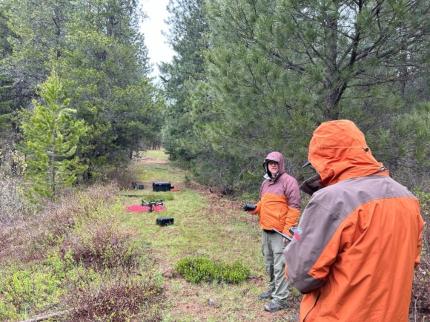Managing Wildlife Populations
Sandhill Crane Surveys by Drone: Biologist Bergh enlisted the help of Remote Sensing and GIS Analyst Jansen and GIS and Data Support Analyst Simper to get aerial imagery of three different sandhill crane nesting areas. The group used three different types of drones and tried regular (RGB) imagery as well as infrared (IR) imagery to identify sandhill crane nests.
Bergh, Jansen, and Simper tried different heights above the ground, both with speed and with the drone stationary. After several days of flying, they determined which drone, imagery, and height would be optimal for spotting nests. They found nests at two of the three sites, although not all of the imagery from the third site has been searched. Disappointingly, the IR imagery did not seem to be useful since it was impossible to differentiate cranes from other waterfowl and even with cloudy skies and cool temperatures, the wetland vegetation appeared “warm.” Next year’s drone survey flights should be more straightforward with the information learned this year.

Northwestern Pond Turtle Hatchling Collection: Biologists Bergh, Wickhem, and Ott spent time collecting hatchling northwestern pond turtles (NWPT) the size of silver dollars to send to the Oregon Zoo as part of the northwestern pond turtle “headstarting” program. The goal of the program is to grow the hatchling turtles to a size of 50 to 100 grams. By the time they reach that size, they are better, faster swimmers, and too large to be swallowed by bullfrogs. Bullfrogs are not native to the Pacific Northwest and easily prey on northwestern pond turtle hatchlings, which is one of the causes of northwestern pond turtle declines in Washington.


Headstart Turtle Notching: Biologists Wickhem and Ott visited headstarted northwestern pond turtles at the Oregon Zoo this week. The turtles were brought to the zoo as hatchlings in May 2023. Under the care of zoo staff members, they can grow larger in a safe setting and be released back into their natural habitat at a size that allows them to more easily avoid predators.
Wickhem and Ott assigned these headstarted turtles identification numbers and put notches in their shell scutes using a triangle file. These notches do not harm the turtles and will help staff members identify these individuals the next time they are captured in the field. Wickhem and Ott also took weights and shell measurements and checked PIT tags on all the headstarts.
The captive cougar, Pai, supervised the headstart activities from his neighboring enclosure, which has become a welcome tradition. These turtles will be released at a site in Skamania County in late May.


Conserving Natural Landscapes
Mudflow Unit Opens After Winter Closure: On the first day of May, Technician Crane removed “No Trespassing” signs on the Mudflow Unit of Mount St. Helens Wildlife Area that were posted for the winter closure. The Mudflow Unit’s annual winter closure is in effect from Dec. 1 through April 30 to ensure minimal disturbance to elk on their over wintering grounds.
The opening of the Mudflow Unit on May 1 each year is popular for shed hunting. While removing signs, Technician Crane observed six shed hunters on the Mudflow Unit, most of which were successful in legally collecting antlers.
